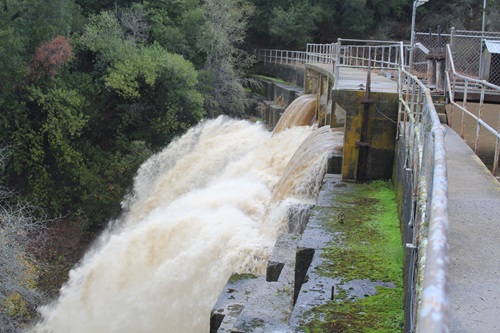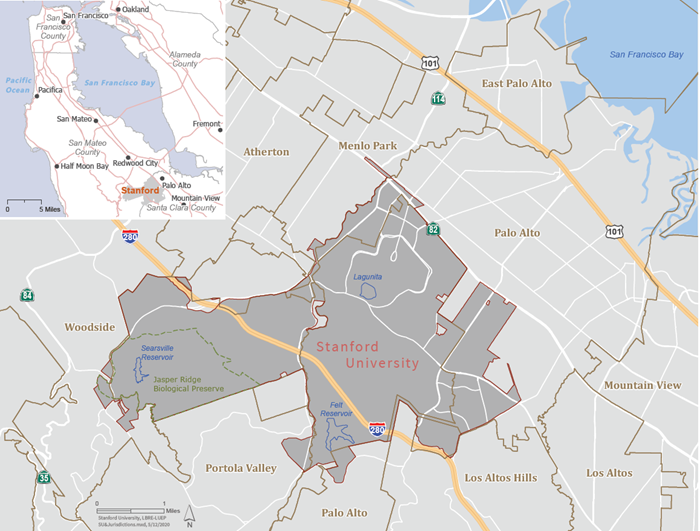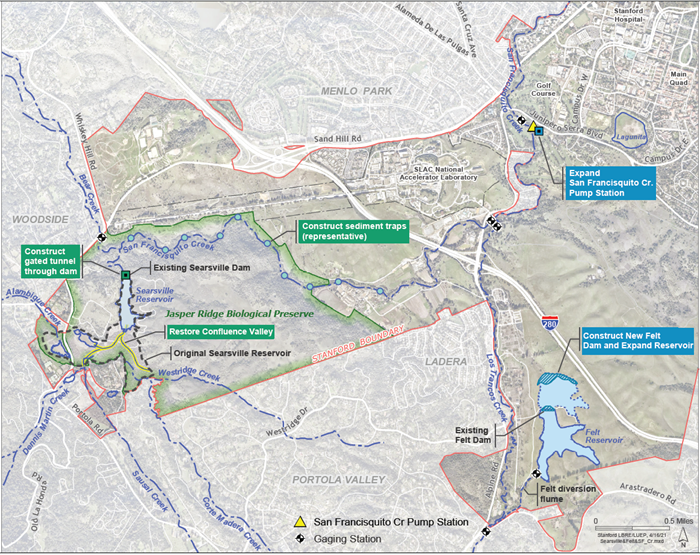Searsville Watershed Restoration Project

Water flowing through the spillway bays and down the face of the Searsville Dam after a storm on Nov. 30, 2012. Photo courtesy of Stanford University.
What is the Searsville Watershed Restoration Project?
In 2011, Stanford University began formal development of a proposed project to address water supply, flood risk, and environmental improvements related to Searsville Dam, Felt Dam and existing San Francisquito Creek pump station diversion facilities. Stanford formed both a Steering Committee and the Searsville Advisory Group to guide the proposed project's goals and actions.
The Department of Water Resources (DWR) is the California Environmental Quality Act (CEQA) lead agency on behalf of Stanford University.
Where is the project located?
The proposed Searsville Watershed Restoration Project takes place in San Mateo and Santa Clara Counties, near the communities of Woodside, Palo Alto, and Portola Valley.
What led to the development of the project?
In the early 1900s, Stanford University purchased the Searsville Dam and associated water rights to ensure adequate water supply for the University campus. After 130 years of operation, the Searsville Dam Reservoir has become nearly filled with accumulated natural sediments, reducing the water storage capacity by 90%. The accumulated sediment has impacted available surface water supplies for university properties, and the presence of the dam affects ecosystem functions within the watershed.
The Stanford Steering Committee and the Searsville Advisory groups agreed any future project must address the following objectives:
- Restore natural downstream sediment and creek flows
- Restore natural fish passage past Searsville dam
- Avoid increasing flood risks downstream compared to existing conditions
- Protecting important cultural resources in the project footprint
- Minimize disruptions to Jasper Ridge Biological Reserve ongoing research
How would the proposed project work?
Stanford University in partnership with the Searsville Advisory Team and federal and State resources agencies developed a proposed project consisting of the following key project components:
- A large tunnel and gate system at the base of Searsville Dam to safely reduce peak stormwater flows and allow sediment to pass downstream
- Re-establishing natural creek (pilot) channels within Searsville reservoir sediment basin to direct flows and sediment through the proposed tunnel
- Restore natural streambank vegetation to stabilize banks along creek channels in the reservoir basin
- Install downstream log and boulder instream habitat structures/sediment traps
- Modify and update San Francisquito Creek Pump Station to upgrade pumping capacity and operational flexibility for improved water supply and streamflow management ecosystem benefits
- Rebuild Felt Dam and Reservoir to increase storage capacity to replace historic non-potable water supplies, add water supply reliability during droughts, and improve earthquake safety
Supporting Water Supply Sustainability
Stanford’s proposed project includes replacing the surface water diversion and storage capacity through modifications to the downstream San Francisquito Creek Pump Station and replacing Felt Dam to add storage capacity to Felt Reservoir.
Managed Flood Flows and Sediment:
Stanford’s proposed project includes constructing a tunnel and gate at the base of Searsville Dam. The gate system would be used to control storm flows through the tunnel allowing for accumulated sediment in the reservoir basin to be flushed downstream through San Francisquito Creek and ultimately out to San Francisco Bay. The tunnel will constrict the highest flood flows thereby reducing water surface elevations in the channel downstream and helping reduce flood risks to the communities downstream.
Supporting Ecosystems:
The reservoir basin of Searsville Dam will be restored and managed to create a highly functioning confluence valley with riparian areas, meandering creeks, floodplain terraces and wetland areas supporting new biodiversity of native habitats and vegetation that support native wildlife of concern for California.
Supporting Fish Passage:
The proposed project includes the construction of a tunnel at the base of Searsville Dam. The tunnel is designed to allow natural sediments to be flushed from the reservoir basin, which will help redistribute coarse sediment in the creek downstream of the dam. This design is intended to restore important complexity to the bedload, which can improve aquatic organism and fish habitat spawning and rearing conditions in San Francisquito Creek.
The proposed tunnel is designed to allow free fish passage upstream of the Searsville Dam. Specifically, the tunnel is intended to provide opportunity for various native species, including California Central Coast steelhead, Sacramento suckers, California roach, three-spined sticklebacks, and other native aquatic and amphibian species to access the upper watershed above the dam.
Project Proponent:
Stanford University is the project proponent. For more information about Stanford’s work on the Searsville Watershed Restoration Project please visit:
https://searsville.stanford.edu/
California Environmental Quality Act (CEQA):
The Department of Water Resources (DWR), through its review authority of the proposed project under the Division of Safety of Dams (DSOD), is the CEQA lead agency for the Searsville Watershed Restoration Project which is proposed by Stanford.
Project Status: (Check back here for updates)
Two virtual public scoping meetings were held on February 28, 2023 to present information to the public and to receive comments from the public on the proposed project, alternatives, and the scope of the environmental analysis. Recordings of the first meeting and second meeting are available to view.
February 14, 2023 – DWR released the Notice of Preparation (NOP) of an Environmental Impact Report (EIR), consistent with the requirements of CEQA. The Public Scoping comment period has been extended from the original March 17, 2023 deadline to April 7, 2023.
Access this NOP, Project number SCH# 2023020346, at the State Clearinghouse website CEQAnet.


